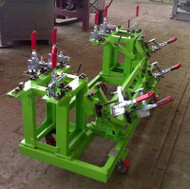How to Choose the Right Vertical Toggle Clamp for Your Needs
Posted by iMark on Feb 6th 2025
Vertical toggle clamps are essential tools in manufacturing, woodworking, and metalworking. They use leverage to provide strong holding power while taking up little space - perfect for tight work areas.
Imagine this: You're preparing for a complicated machining task and need a dependable way to hold your workpiece in place. That's where a vertical toggle clamp comes in. It has a clever design that uses a simple downward push of the handle to generate significant holding force.
Why Choose Vertical Toggle Clamps?
-
Fast and Easy to Use: With their one-handed operation, vertical toggle clamps allow you to quickly secure your workpiece without wasting time.
-
Space-Saving Design: Unlike traditional clamps that require horizontal space, these clamps have a vertical design that maximizes workspace efficiency.
-
Consistent Pressure: The unique mechanism of vertical toggle clamps ensures uniform clamping pressure every time, resulting in precise and repeatable results.
-
Secure Workholding: Say goodbye to worries about your workpiece shifting or moving during operations. These clamps provide reliable security, giving you peace of mind.
Choosing the Right Clamp Matters
The right vertical toggle clamp can greatly improve your work quality and efficiency. It can reduce setup time, enhance safety, and ensure consistent results across projects. On the other hand, making the wrong choice could lead to damage, inconsistency, or even safety hazards.
At Ridiculous Machine Tools, we know how important these clamps are for your work. That's why we've put together this comprehensive guide. Inside, you'll find expert tips and practical advice on selecting the perfect vertical toggle clamp for your needs. Whether you're setting up a professional workshop or upgrading your home workspace, this guide will help you make an informed decision.
Understanding Vertical Toggle Clamps
Vertical toggle clamps have a unique design that makes them stand out among other clamping solutions. What sets them apart is their handle, which moves vertically and operates at a right angle to the surface being clamped. This design uses a linkage system to create a mechanical advantage, allowing you to apply a large holding force with minimal effort.
Key Design Features:
-
Vertical operating handle for space-efficient clamping
-
Toggle mechanism with pivot points for force multiplication
-
Adjustable spindle assembly for precise pressure control
-
Base plate with mounting holes for secure attachment
-
Heavy-duty steel construction for durability
The vertical handle design makes these clamps especially useful in situations where there is limited overhead space. They are commonly used in various industries such as woodworking, metalworking, and manufacturing.
Applications of Vertical Toggle Clamps:
Here’s a table organizing the applications of toggle clamps across different industries:
|
Industry |
Applications |
|
Woodworking |
- Router tables |
|
|
- Drill press operations |
|
|
- Edge banding processes |
|
Metalworking |
- Welding fixtures |
|
|
- CNC machining setups |
|
|
- Assembly line operations |
|
Manufacturing |
- Production line automation |
|
|
- Quality control testing |
|
|
- Component assembly |
The benefits of vertical toggle clamps go beyond just saving space. Their efficient design helps reduce fatigue for operators during repetitive clamping tasks. The vertical movement of the clamp also provides better stability, which is especially important when working with delicate materials or achieving precise alignments.
Performance Benefits:
-
Up to 2500 lbs of holding capacity depending on model
-
Quick one-handed operation
-
Self-adjusting pressure maintenance
-
Reduced workspace interference
-
Consistent clamping force across multiple cycles
These clamps are particularly effective in automated production settings where reliability and consistency are crucial. The vertical motion of the clamp allows for smooth integration with robotic systems and automated handling equipment. Additionally, their compact size makes them suitable for setups with multiple clamps in tight spaces.
Key Factors to Consider When Choosing a Vertical Toggle Clamp
Types of Clamps and Their Applications
Vertical toggle clamps differ significantly from their horizontal counterparts in both design and functionality. Vertical clamps excel in:
-
Limited workspace scenarios - ideal for tight spaces where horizontal movement is restricted
-
Downward pressure applications - perfect for securing workpieces flat against a surface
-
Quick-release operations - enables rapid workpiece changes in production environments
Horizontal clamps, by contrast, work best for side-mounting applications and scenarios requiring lateral pressure distribution.
Understanding Force Dynamics
Two critical force measurements determine a toggle clamp's effectiveness:
Clamping Force
-
Initial pressure applied when securing the workpiece
-
Measured in pounds or kilograms
-
Typically ranges from 150 to 7000 pounds
Holding Force
-
Sustained pressure maintaining the workpiece position
-
Must exceed clamping force for secure retention
-
Varies based on handle position and clamp design
Handle Design and Ergonomics
Handle configuration plays a vital role in user comfort and operational efficiency:
-
T-shaped handles provide maximum leverage with minimal effort
-
Curved designs reduce wrist strain during repeated use
-
Rubber-coated grips enhance control and prevent slippage
The optimal handle length correlates directly with the required clamping force - longer handles generate greater mechanical advantage for heavy-duty applications.
Pressure Application Points
Different clamp designs offer varying pressure distribution patterns:
-
Single-point contact - suited for small, uniform workpieces
-
Multi-point systems - ideal for larger or irregular shapes
-
Adjustable pressure pads - accommodate varying material thicknesses
Your specific application requirements should guide your selection among these pressure application options.
Additional Considerations for Selecting the Perfect Vertical Toggle Clamp
Workpiece Size and Shape Compatibility
The dimensions of your workpiece directly impact your clamp selection. Here's what you need to consider:
-
Height Range: Your vertical toggle clamp must accommodate your workpiece's height while maintaining proper clamping pressure
-
Reach Requirements: Select a clamp with sufficient arm length to reach across your workpiece
-
Base Mounting Space: Ensure you have adequate mounting surface for the clamp's base plate
For irregularly shaped materials, consider these specialized solutions:
-
Adjustable spindle heads to match contoured surfaces
-
Rubber-tipped contact points for delicate or uneven surfaces
-
Extended reach models for complex geometries
Material Selection for Durability
Your choice of clamp material affects both performance and longevity:
Steel Clamps
-
Ideal for heavy-duty applications
-
Resistant to wear and deformation
-
Suitable for high-temperature environments
-
Available in zinc-plated options for corrosion resistance
Stainless Steel Options
-
Perfect for food-grade or medical applications
-
Superior rust and chemical resistance
-
Higher initial cost but longer lifespan
-
Ideal for wet or corrosive environments
Aluminum Variants
-
Lighter weight for portable applications
-
Good strength-to-weight ratio
-
Cost-effective for light to medium-duty use
-
Less suitable for high-stress applications
Match your clamp's material specifications to your workpiece requirements. A steel clamp might be excessive for light woodworking but essential for metal fabrication. Consider the frequency of use - daily operations demand higher-grade materials than occasional projects.
For specialized applications, look for clamps with protective coatings or treatments that enhance durability. These features protect against:
-
Chemical exposure
-
UV radiation
-
Temperature fluctuations
-
Mechanical wear
Ensuring Safety and Reliability in Your Vertical Toggle Clamp Choice
Your operating environment plays a crucial role in selecting the right vertical toggle clamp material. In corrosive environments, stainless steel clamps prevent rust and deterioration. High-temperature settings require heat-resistant materials like hardened steel with specialized coatings. For clean room operations, non-marking materials and sealed mechanisms prevent contamination.
Duration Impact on Clamp Selection
-
Short-term projects: Standard steel clamps suffice
-
Continuous operations: Heavy-duty materials with reinforced components
-
Intermittent use: Rust-resistant coatings protect during idle periods
-
24/7 production: High-grade materials with enhanced wear resistance
The length of clamping time directly affects the required holding force. Extended clamping periods demand higher strength ratings to maintain consistent pressure. You'll need a clamp rated at least 20% above your calculated holding force for sustained operations.
Essential Safety Features
-
Secondary locking mechanisms
-
Anti-slip grip surfaces
-
Visual position indicators
-
Emergency release systems
-
Overload protection
These safety elements protect both operators and workpieces. Secondary locks prevent accidental release during vibration or movement. Position indicators ensure proper engagement before operation begins.
Manufacturer Considerations
-
Industry certifications
-
Quality control standards
-
Warranty coverage
-
Replacement parts availability
-
Technical support access
Reliable manufacturers like Ridiculous Machine Tools maintain strict quality control processes. Their clamps undergo rigorous testing before distribution. You benefit from comprehensive warranty protection and readily available replacement components.
The manufacturer's reputation reflects their commitment to product excellence. Look for companies with established track records in toggle clamp production. Check user reviews and industry feedback for real-world performance insights. Quality manufacturers provide detailed specifications and load ratings for their products.
Conclusion
Choosing the right vertical toggle clamp requires careful thought about your specific needs. By assessing your workspace, materials, and safety requirements, you can find the perfect clamp for your situation.
Take the time to understand your needs, seek advice from professionals, and make an informed decision when choosing a clamp that will reliably serve you for many years ahead.
FAQs (Frequently Asked Questions)
What factors should I consider when choosing a vertical toggle clamp?
Key factors include the type of clamp (vertical vs horizontal), clamping and holding force requirements, handle shape for ease of operation, size and shape of the workpiece, material compatibility for durability, and the operating environment where the clamp will be used.
How does the handle shape influence the usability of a vertical toggle clamp?
The handle shape significantly impacts user experience and ease of use. Ergonomic designs can reduce strain during operation, making it easier to apply the necessary clamping force while ensuring comfort during prolonged use.
What are some common applications for vertical toggle clamps?
Vertical toggle clamps excel in applications such as woodworking projects, where space is limited for maneuvering. They are also commonly used in metalworking, assembly lines, and any situation requiring reliable workpiece stabilization.
Why is it important to consider safety features when selecting a vertical toggle clamp?
Safety features, such as secondary locks, are crucial for protecting users during operation. These features help prevent accidental release of the workpiece, ensuring safe handling and reducing the risk of injury.
How can I ensure that I select a durable vertical toggle clamp?
To ensure durability, consider the material selection based on your specific workpiece type and environmental conditions. Additionally, choosing clamps from reputable manufacturers known for quality can greatly enhance product longevity.


